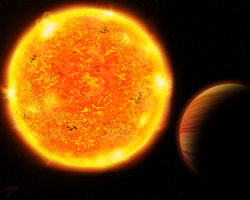Astronomy:HD 102956 b
Coordinates: ![]() 11h 51m 23.0s, +57° 38′ 27″
11h 51m 23.0s, +57° 38′ 27″
 Artist's impression HD 102956 b | |
| Discovery[1] | |
|---|---|
| Discovered by | Johnson et al. |
| Discovery site | Keck Observatory |
| Discovery date | 2010 |
| Doppler spectroscopy | |
| Orbital characteristics[2] | |
| 0.0807±0.0073 astronomical unit|AU | |
| Eccentricity | 0.037±0.019 |
| Orbital period | 6.49470±0.00019 d |
| |{{{apsis}}}|helion}} | 2455351.45±0.64 JD |
| 301±33 º | |
| Semi-amplitude | 74.6±1.8 m/s |
| Star | HD 102956 |
| Physical characteristics[2] | |
| Mass | ≥0.960±0.023 Jupiter mass |
| Observation data Equinox J2000.0]] (ICRS) | |
|---|---|
| Constellation | Ursa Major |
| Right ascension | 11h 51m 22.5111s[3] |
| Declination | +57° 38′ 26.6427″[3] |
| Characteristics | |
| Evolutionary stage | Main sequence |
| Spectral type | A |
| Astrometry | |
| Radial velocity (Rv) | −25±83 km/s |
| Proper motion (μ) | RA: −11.24±0.049[3] mas/yr Dec.: −17.578±0.049[3] mas/yr |
| Parallax (π) | 8.1753 ± 0.0290[3] mas |
| Distance | 399 ± 1 ly (122.3 ± 0.4 pc) |
| Absolute magnitude (MV) | 2.5 |
| Details | |
| Mass | 1.68±0.11 M☉ |
| Radius | 4.4±0.1 R☉ |
| Luminosity (visual, LV) | 11.6±0.5 L☉ |
| Temperature | 5054±44 K |
| Metallicity [Fe/H] | +0.19±0.04 dex |
| Rotational velocity (v sin i) | 0.30 km/s |
| Other designations | |
| Database references | |
| SIMBAD | data |
| Exoplanet Archive | data |
HD 102956 b or Isagel is an extrasolar planet discovered in 2010 by a team of American astronomers led by John Johnson using Doppler spectroscopy and the Keck Observatory in Hawaii. HD 102956 b is in the orbit of host star HD 102956. The planet is at most the mass of Jupiter, orbiting every 6.5 days at a distance of 12 million km. HD 202956 b has a very circular orbit.[1] The system is roughly 399 light years from us.
Discovery and nomenclature
The name HD 102956 derives directly from the fact that the star is the 102,956th star catalogued in the Henry Draper catalog. The designation of b is given to the first planet orbiting a given star.
The star is one of the 2.5 million brightest stars in the sky and is part of the Tycho-2 Catalogue. It is not visible to the naked eye with an apparent magnitude of 8.
NameExoWorlds
In 2019 this planet was announced as part of the IAU NameExoWorlds project[5] where it was designated as the planet that will be named by Sweden. The winning proposal was Isagel, from Nobel laureate Harry Martinson's space poem Aniara.[6]
Characteristics Host Star
HD 102956 (Aniara) is an orange subgiant with a mass and radius of 1.68 and 4.4 solar, respectively. The surface temperature is about 5054 Kelvin. The luminosity of the star exceeds that of the sun by 11.6 times. The star's age is estimated at about 2.3 billion years.
Habitability and possibility of life
Since HD 102956 b is a hot Jupiter it is unlikely that it harbors life.
References
- ↑ Jump up to: 1.0 1.1 Johnson, John Asher et al. (2010). "A Hot Jupiter Orbiting the 1.7 M☉ Subgiant HD 102956". The Astrophysical Journal Letters 721 (2): L153–L157. doi:10.1088/2041-8205/721/2/L153. Bibcode: 2010ApJ...721L.153J.
- ↑ Jump up to: 2.0 2.1 Luhn, Jacob K. et al. (2019). "Retired A Stars and Their Companions. VIII. 15 New Planetary Signals around Subgiants and Transit Parameters for California Planet Search Planets with Subgiant Hosts". The Astronomical Journal 157 (4): 149. doi:10.3847/1538-3881/aaf5d0. Bibcode: 2019AJ....157..149L.
- ↑ Jump up to: 3.0 3.1 3.2 3.3 3.4 Brown, A. G. A. (August 2018). "Gaia Data Release 2: Summary of the contents and survey properties". Astronomy & Astrophysics 616: A1. doi:10.1051/0004-6361/201833051. Bibcode: 2018A&A...616A...1G. Gaia DR2 record for this source at VizieR.
- ↑ "HD 102956". SIMBAD. Centre de données astronomiques de Strasbourg. http://simbad.u-strasbg.fr/simbad/sim-basic?Ident=HD+102956.
- ↑ "Name an exoplanet (press release)". 2019-06-06. http://www.nameexoworlds.iau.org/sweden. Retrieved 2019-06-13.
- ↑ "Rymddikt gav namn åt Sveriges exoplanet" (in Swedish). 2019-12-17. https://fof.se/artikel/rymddikt-gav-namn-sveriges-exoplanet. Retrieved 2021-08-10.
Coordinates: ![]() 11h 51m 23.0s, +57° 38′ 27″
11h 51m 23.0s, +57° 38′ 27″
 |


